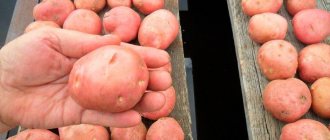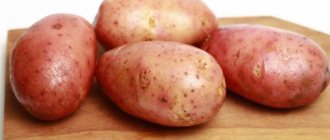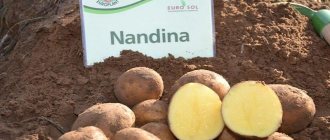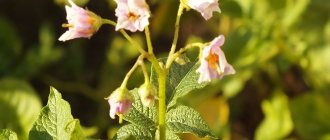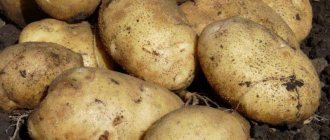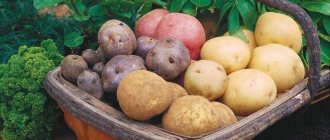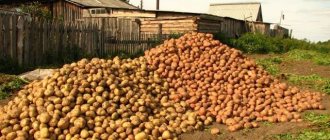Characteristics of Red Lady potatoes
The variety was developed by scientists from Germany. After lengthy research, in 2008 the variety was recognized by the State Register and immediately gained great popularity among summer residents for its ease of care and early ripening.
Red Lady is an ideal variety that can grow and develop even under unfavorable weather conditions. Therefore, it is recommended to grow it in the Central, Caucasus, Volga-Vyatka regions and the Far East.
Red Lady potatoes are an early ripening variety. About 50 days pass from planting to harvest, but for long-term storage of the crop, the bushes are dug up after 3 months. The culture has a spreading, compact bush with dark green foliage. The variety is immune to diseases and pests, is not afraid of drought and is resistant to heat.
Advice! The Red Lady variety is universal in use; it can be stewed, fried, mashed, chips and French fries.
Advantages and disadvantages of the Lady Red variety
Potatoes are a crop that is part of a set of vital products. Meat eaters and vegetarians all eat potatoes. Summer residents and rural residents grow this root crop on their plots of land.
Before choosing a good variety for your farm, evaluate its characteristics.
The advantages of Red Lady include:
- early ripeness;
- drought resistance;
- good taste, widely used in cooking;
- little susceptible to fungal and viral diseases, as well as scab and golden nematode;
- well stored;
- endures transportation;
- it is possible to grow in small quantities and on an industrial scale;
- versatility in use;
- high yield.
Pros and cons of the Red Lady potato variety
Red Lady potatoes, according to gardeners, have their positive and negative qualities. The advantages include:
- early ripening and long growing season;
- good taste;
- immunity to diseases;
- good shelf life and transportation;
- high content of useful substances.
The disadvantages include:
- for a bountiful harvest, you need to regularly apply complex mineral fertilizers;
- the quality of the harvest is affected by the length of daylight hours;
- If care is not followed, late blight often occurs.
Bellarosa potatoes. Root vegetable
Bellarosa is a table potato variety bred by German breeders and successfully cultivated in temperate climate zones.
It is grown mainly in the vastness of Ukraine, Moldova and almost everywhere in Russia. The main characteristic features of the Bellarosa variety, for which it is especially valuable, are:
Precocity. Harvesting takes place within 50-60 days after planting, and digging can be done as early as 45 days. In the southern regions, it is possible to harvest two harvests per season: after the first harvest in the first ten days of July, you can use the freed areas for the next planting. The second collection occurs in the first ten days of September.
Productivity. The yield of this variety is stable and quite high - up to 20-35 tons from 1 hectare of land.
You can compare the yield and keeping quality of a variety with others using the table below:
Drought resistance. Bellarosa tolerates dry weather conditions absolutely calmly. Being unpretentious and undemanding to humidity makes it possible to grow potatoes in large areas that are not equipped.
Demanding requirements for soils. Bellarosa grows well in all types of soils, except heavy clay ones.
Use and taste. Table potato variety. When assessed on a five-point scale, the taste quality corresponds to a rating of “5”. After heat treatment, moderate friability remains.
The taste of potatoes largely depends on the amount of starch in its tubers. In the table below you can see what this indicator is for different varieties:
Resistance to mechanical damage. Stability is high - when harvested, almost 99% of the tubers remain in excellent condition.
Disease resistance. Bellarosa is indifferent to bacterial rot, viruses, golden potato cyst, rhizoctonia and blackleg.
Storage . This variety stands out among other early varieties due to its excellent keeping quality. Early potatoes often don't last long, but Bellarosa is an exception. Storage losses reach a maximum of 6%. All this is due to its resistance to damage during harvesting and to diseases.
Planting and caring for Red Lady potatoes
To harvest large potatoes, you need to choose the right place, prepare planting material and follow the rules of care. The Red Lady variety is unpretentious and suitable for both experienced and novice gardeners.
Selection and preparation of a landing site
Varietal potatoes prefer to grow in a sunny place in sandy, light soil. The bed is prepared in the fall, the ground is dug up, organic matter is added and covered with mulch.
A good harvest can be obtained on land where carrots, beets, cucumbers, legumes and cereals previously grew.
Important! If you plant several varieties nearby, you can lose varietal characteristics, since during flowering the plants will begin to cross-pollinate.
Preparation of planting material
Before planting, it is necessary to sort and prepare planting material. First of all, medium-sized tubers are selected, without mechanical damage or signs of rot. The fruits should not be dense, weighing up to 100 g.
To get an early harvest, the tubers need to be sprouted. To do this, they are kept for 3 weeks in a well-lit place. You can also germinate tubers in plastic bags:
- take plastic bags and make small holes in them for ventilation;
- Up to 10 fruits are placed in 1 bag;
- Thanks to the greenhouse effect, germination occurs after 2 weeks.
After the emergence of seedlings, the planting material is treated with a growth stimulator. For this you can use drugs:
- "Prestige";
- "Matador";
- "Kaiser".
Landing rules
Depending on the region, varietal potatoes can be planted from late April to early June. The main requirement is that the soil warms up to 10 degrees and the absence of night frosts.
Advice! Many gardeners adhere to folk wisdom: if the bird cherry blossoms, it means it’s time to plant potatoes.
The landing pattern is simple:
- the interval between rows is half a meter;
- between holes – 35 cm;
- planting depth – 10 cm.
To make it easier to care for and harvest, experienced gardeners recommend staggered planting. Add 1 tsp to each prepared well. ammophos or a handful of wood ash. The tubers are sprinkled with earth, the soil is compacted, watered generously and mulched.
Caring for Red Lady potatoes is easy. It consists of weeding, hilling, watering and fertilizing.
Watering and fertilizing
Red Lady potatoes are a drought-resistant variety. Therefore, abundant watering is carried out during flowering, since during this period the fruits are formed.
Fertilizing is applied several times per season:
- When seedlings appear, 500 g of mullein and urea are used per 10 liters. Consumption per bush is about 0.5 liters.
- At the budding stage, add 15 g of double superphosphate, potassium sulfate and 100 g of wood ash to a bucket of water. For 1 bush, 0.5 liters of solution is consumed.
- When flowering, a month before harvesting, add 30 g of superphosphate and 250 ml of slurry to 10 liters of water.
Loosening and weeding
Weeding is carried out as the weed grows. When weeding potato beds, you should not remove all weeds; you need to get rid of fast-growing and thorny specimens. You can leave the small change, since when weeding and hilling, their root system is damaged, and the plant dries out over time.
Loosening is necessary for better penetration of oxygen to the root system. The first procedure is carried out after the seedlings have germinated by 10 cm and continues every 2-3 days until the tops close. The soil must be loosened between the bushes and between the rows.
The frequency of loosening depends on the type of soil. For light, sandy soil, 2-3 times per season is sufficient; clayey soil is loosened after each irrigation.
Hilling
Hilling is carried out several times per season. It is necessary so that the stolons, and therefore the tubers, ripen faster.
Important! Stolons are formations on the root system on which tubers develop.
Hilling affects the quality and quantity of the harvest. It is carried out in 2 ways:
- Classic - the earth is raked into the bed from the row spacing. Thanks to early hilling, the tops are covered by ½ soil, builds up an additional root system and increases productivity.
- Fan - with this method, the soil is not raked on the sides, but placed inside the bush. The technique is simple: the stems are carefully pushed apart in different directions and the middle is covered with earth. Thanks to the access of sunlight to the entire plant, the yield increases by 2 times.
Advice! The first hilling is after the emergence of seedlings, the second – a month after the first.
Optimal conditions for growing potatoes
Growing Lady Red potatoes is not difficult; you can follow standard planting techniques.
Seedlings should be purchased from nurseries or from trusted market sellers.
Before purchasing, you need to read the quality certificate. The document includes information about the characteristics of the type, data about the batch, and supplier contacts. It is advisable to choose the elite; part of the harvest of such root crops can be continuously used for planting on the territory for 4-5 years without renewal. Plant on loose black soil with plenty of sand. In the North, you can grow potatoes in greenhouses, and in the South and mid-latitudes - in the garden.
Selection and preparation of a site
Red lady potatoes prefer to grow in a well-lit place where there are no tall trees. The beds are prepared in the fall, the soil is dug up, organic matter is added, and covered with mulch. Optimal predecessors include carrots, beets, cucumbers, legumes and cereals. 2 weeks before planting, loosen the soil again and remove weeds.
Preparing planting material
Before planting, seedlings are sorted. Medium-sized specimens with no damage or rot are selected. Fruits must weigh up to 100 grams. To obtain an early harvest, it is advisable to germinate the tubers. They are kept for 3 weeks in a lighted place. Before planting, dip the seedlings in a solution that stimulates rhizome growth for 30 minutes. Effective means include Prestige, Matador, Kaiser.
Planting dates and technology
Red lady potatoes are planted when the soil warms up to +10 degrees. This usually occurs in mid or late April. The soil is fed with manure and superphosphate in the fall. In the spring, ash and complex biological products are added to the holes.
A distance of 60 cm is maintained between rows, 35-40 cm between bushes. Planted to a depth of 5 cm, unsprouted tubers - 8-10 cm.
Diseases and pests
Red Lady potatoes, judging from the description of the variety, have strong immunity to many diseases, but are very sensitive to late blight.
Late blight is a dangerous fungal disease that often affects potato tubers. The fungus develops intensively in rainy and warm weather. The first signs of the disease:
- dark spots appear on the leaves;
- the tops become brown and dry out over time.
Advice! To prevent the disease, it is necessary to grow potatoes after mustard.
When the disease appears, the bushes are treated with Agat or Ridomil solutions.
If the care rules are not followed, Red Lady, like other potato varieties, may develop:
- Leaf chlorosis. The disease can be detected by the foliage; it turns yellow with pronounced green veins. You can get rid of the disease by treating the plant with copper sulfate.
- Black scab. When the disease occurs, the growth and development of the plant stops.
- Brown bacterial rot. This disease affects tubers. The disease manifests itself during the flowering period. The leaves turn yellow, wrinkle and wither.
The most common pests are Colorado potato beetles. They often appear on crops grown in regions with warm climates. The pest is dangerous to crops for several reasons:
- due to great gluttony, the bushes completely disappear in a short time;
- the beetle is very tenacious, it is not afraid of the cold, insects are capable of falling into suspended animation and hibernate underground;
- fly from plant to plant;
- quickly get used to insecticides.
Care instructions
Caring for potatoes involves removing weeds from the area, fertilizing and hilling. As for watering, the variety is able to tolerate drought. However, to increase yield, plants need to be watered once a week.
Important! Crops especially need watering during flowering and during fruit formation.
Storage
You can determine the time to collect tubers by looking at the foliage; it begins to turn yellow and fade. The main condition is to harvest before the first frost.
Potato bushes are carefully dug up with a shovel or pitchfork, the bush is pulled out by the tops, the tubers are separated and placed in a bucket. After harvesting, you need to sort out the potatoes. To do this, it is sorted by size and all spoiled vegetables are removed. Tubers with minor mechanical damage, cuts and dents are used first.
To preserve the harvest as long as possible, it is treated with copper sulfate (2 g of powder per 10 liters of water). The prepared tubers are placed in a box and placed in a dry, ventilated, dark and cool room.
Harvest and storage
Red lady potatoes are harvested 55 days after emergence and tops wilting. Mechanical or manual cleaning is possible. Usually the fruits are collected in August-September. Afterwards, the bushes are removed and the soil is dug up according to the rules.
The tubers are placed under a canopy and kept in the fresh air for 3-4 hours. When the crop is dry, sort it out and discard rotten and damaged specimens. Place suitable potatoes in a wooden box in a layer of 0.5 meters.
Store vegetables in a basement or cellar with an air temperature of up to +4, humidity 90%. Every 3 days, ventilate the room and inspect the tubers.
Reviews of Red Lady potatoes
Ilyinskaya Ekaterina Georgievna, 65 years old, Voronezh
I am an experienced gardener. Every year I grow potatoes on the plot. I found out about the early ripening Red Lady variety, planted it and was not disappointed. The harvest was abundant, the tubers were tasty, not watery, with a beautiful color and strong skin. I especially like the fact that the crop ripens 2 months after planting and in the summer you can eat your own young potatoes.
Efremov Nikolay Andreevich, 56 years old, Anapa
I have been planting the Red Lady variety for a long time. Productivity is high, good taste. Over time, productivity decreased. I couldn’t understand why, but it turned out that the variety cannot be planted in one place for more than 5 years in a row. I changed the place and the variety began to surprise with renewed vigor. I recommend the unpretentious Red Lady potatoes to everyone.
Pests and diseases
It was said above about resistance to diseases such as potato cancer, scab, and golden potato nematode. But late blight can affect plant stems; to avoid this, regular preventive treatments with fungicides are carried out.
Some pests are not averse to eating potatoes, these include wireworms, Colorado potato beetles, and mole crickets. The description of the Colorado potato beetle is probably known to everyone. Complete destruction of the insect is impossible, therefore, in order to minimize losses, its larvae are collected and burned or thrown into a jar with a strong saline solution.
Under no circumstances should you crush beetles and larvae on the ground. Unfortunately, this method is only suitable for amateur plantings; for industrial scales, other methods will have to be used.
It’s easy to “diagnose” wireworms—single wilted bushes; when digging, there are small through holes on the tubers. In summer, it can be noticed when weeding or loosening, since the larvae live in the upper layers of the soil during the warm period. It is difficult to get rid of it, so it is better to prevent the pest from appearing in advance. There are several preventive measures:
Compliance with agricultural technology and crop rotation. Some gardeners consider this an optional rule, but regularly planting the same crop leads to decreased fertility and disease. Remove all organic debris. Parts of plants left in the ground will begin to rot and will be ideal food for the pest, so carefully inspect the soil before wintering. Maintaining a neutral PH level. Wireworm thrives in highly acidic soil
To find out this characteristic, you can take samples to a laboratory, but you can also pay attention to indicator plants. Plantain and sorrel are characterized by high acidity, so the soil must be mixed with dolomite flour and lime. Planting protective plants such as dahlias, legumes (which are also considered an excellent predecessor for potatoes).
Advantages of varieties
To decide on the choice of the most suitable variety for cultivation in a household or farm, you should carefully study not only the characteristics, but also evaluate the advantages of each of them.
| Variety name | Maturation period | Marketability of the variety | Keeping quality of the variety | Taste qualities | Productivity | Sustainability |
| "Red Lady" | 70-75 days | 80-94 % | 92 % | High | 167.5-298.0 c/ha | To the causative agent of potato cancer and golden potato cyst nematode |
| "Lady Claire" | 70-75 days | 81-94 % | 94 % | Good | 140.5-260.5 kg/ha | To the causative agent of potato cancer and golden potato cyst nematode |
| "Lady Rosetta" | 120-130 days | 64,5-94,8 % | 4-6 months | Good | 13.2-46.4 kg/10 sq. m | To cancer and potato nematode, has immunity to viruses A and X |
Characteristics and Features
Frost resistance
The variety has average frost resistance. It can withstand short-term temperature drops down to +1…+4 degrees. Compared to the early Adretta variety, Lady Claire seedlings will be damaged if the thermometer drops below zero in May. However, after a short time the stems begin to grow again. Yield loss under such circumstances is negligible. The crop is most afraid of prolonged frosts at the end of June, when flowering occurs and tubers form.
Productivity
Tomato Iron Lady
Lady Claire potatoes are a mid-early variety. Its growing season is just over two months. In this way it resembles Red Lady potatoes. The two varieties can be harvested 75 days after planting. Conditional ripeness occurs 50 days after planting. At this time, the potato plot can already be dug up. It is recommended to boil tubers with thin, flaky skin. At the same time, they retain their shape and color.
The German Red Lady potato variety has slightly different characteristics regarding yield. It is slightly larger than Lady Claire's. As indicated in the data of the State Commission of the Russian Federation for testing and protection of breeding achievements, Lady Claire has a marketable yield of 140-170 c/ha. The maximum yield is 260 c/ha. In turn, Red Lady potatoes can produce 170-300 c/ha.
Important! The maximum yield of Lady Claire tubers can be obtained if the crop is grown on loose black soil, where there is a sufficient amount of sand. Heavy soil will reduce yield.
Bloom
Lady Claire potatoes begin to bloom approximately 25-35 days after planting. This period depends on the preliminary preparation of the tubers. If they were germinated for a month, then flowering will begin 2.5-3 weeks after planting. If you haven't germinated, then in a month. At this time, stolons begin to grow underground, on which tubers are already beginning to form. Flowering occurs quickly.
The corolla is neat and small. White color. Flowers appear at the tops of the stems. Potatoes usually bloom within a week. Afterwards, green berries appear in place of the flowers. However, Lady Claire potatoes tend to drop their flowers after 2-4 days. And berries do not form in their place.
Potatoes bloom
This variety is a flowering variety, so the gardener must monitor the flowering period. If flowers do not appear, it is necessary to identify the cause of this situation. Perhaps the potatoes were planted in a dark place in the garden and were attacked by insect pests. In this case, next year the planting should be organized in a different place. In case of pest invasion, the plantings are treated with insecticides: Death to Bugs, Lux Maxi, etc.
Hive parameters
The stems are powerful and durable. Do not bend throughout the summer. The tops of the crop are spreading. The bush is erect, semi-erect, low - stretches up to half a meter in height. Intermediate type. The stems are covered with leaves. Most leaves are medium in size, some are large. They are elongated. Emerald color. The waviness is weak. Open type. The veins are visible.
Description of tubers
The plant has a well-developed root system. It lies in the ground to a depth of 20-30 cm. Many tubers are formed on one bush - from 10 to 14 pieces. The quality is high. The view is attractive. Marketability is at the level of 90%. There are practically no small and twisted tubers.
Small tubers missing
Medium sized potatoes. Weight – from 80 to 120 g. The shape is elongated, round, closer to oval. There is such a parameter of quality potatoes as the correct shape. Potatoes are leveled. The eyes are small. There are very few of them. They are on the surface. Lady Claire potatoes whose characteristics indicate their suitability for machine washing and cleaning.
The peel is elastic. At first glance, it is thin, but in fact it is quite dense. Potatoes do not tend to crack in the ground. It also does not burst upon impact.
Lady Claire is a type of potato that is yellow in color. The peel is light golden brown. A little rough. The pulp is creamy, white-yellow. Very dense, not watery. Dry matter content – 16-19%. Doesn't boil over. Does not change color for a long time after cleaning and during cooking. Quite a high starch content - 12-16%.
Note! Lady Claire potatoes are quite high in calories. Its nutritional value is 83 kcal. This is slightly higher than many other varieties. The reason is the increased starch content. Not suitable for dietary use.
The variety has a high taste characteristic. Lady Claire potatoes are moderately sweet and buttery. The taste is classic, moderately rich. These potatoes are suitable for boiling and frying. It is the Lady Claire variety that is grown on an industrial scale for processing into potato flour and starch production. French fries and chips are made from it.
Important! Potatoes contain a large amount of vitamins C and B6. Thanks to the consumption of vegetables, brain activity and the body's resistance to viruses increase. Potatoes have a beneficial effect on the nervous system.
Keeping quality and transportability
Despite the fact that the potatoes are mid-early, they are perfectly stored throughout the winter. Its keeping quality is 90-94%. The taste and appearance are not affected during storage. In addition, this variety of potato is perfectly transported over long distances. Tubers do not crack or get damaged on the road.
Resistance to diseases and pests
Lady Claire potatoes are immune to pathogenic fungus, which is the causative agent of potato cancer. It also rarely suffers from potato golden nematode.
The variety can be affected by the fungus that causes potato rot. The second name of the disease is late blight. A sign of the appearance of fungus are black spots that spread on the tops and leaves. A whitish coating is noticeable on the back of the leaf. Fungicides used for control are: Ridomil MC, Agat-25K, Ridomil Gold MC.
Ridomil MC
Common pests: Colorado potato beetle, cutworm caterpillars, potato flea beetle. When fighting them, chemical agents are used: Death to Bugs, Lux Maxi, etc.
Generous in harvest and unpretentious in care potatoes - Lady Claire: description of the variety and characteristics
Dutch varieties are in demand among potato growers around the world. So Lady Claire potatoes have many fans among vegetable growers from Russia, Belarus, and Moldova. Potatoes are unpretentious in care, are rarely affected by infectious pathogens, and produce significant yields - up to 270 centners per hectare.
| Ripening time | starch,% | Weight of tubers, gr. | Number of tubers in a bush | Productivity, c/ha | Keeping quality, % | Peel color | Flesh color | Country of selection |
| Mid-early | 15 | 80-120 | 8-12 | 140-270 | 94 | Yellow | Yellow | Holland |
Description and characteristics of the variety
Lady Claire potatoes are an early-ripening seed variety from the Dutch line. Ripening dates occur in 65-80 days. Young tubers begin to dig up after 40-45 days.
For an earlier harvest, these potatoes can be cultivated in greenhouse conditions. The variety is mid-early.
The bushes are of medium height - at the level of 50-60 cm. The shoots are erect, the foliage is good. The leaves protect from drying out. The tops are strong and do not lie down.
The leaf blades are large, the edges are wavy, and the color is dark green. Moderate flowering, buds with white corollas. There are no berries. In 1 root system, 8-12 large tubers grow - aligned, with a smooth skin. Small things are rare.
Keeping quality 94%, potatoes keep well for up to 6 months.
What you should know about tubers:
- average weight 80-120 g (seed potatoes weigh 60-70 g);
- length 8-14 cm, diameter 6-7 cm;
- oblong shape;
- the color of the skin is rich yellow, and the flesh is light yellow;
- starchiness 15%;
- the texture is not watery;
- dry ingredients content 21%.
Taste quality was rated 4.7 points. Cookability is average. Tubers are prepared in different ways - boiled, fried, baked. The result is always excellent - the puree is fluffy, the borscht is rich, the crispy slices have a fragrant crust. During industrial cultivation, the crop is used for the production of semi-finished products, starch, fries, chips, and dry mixes.
History of the variety's creation
An agricultural group of scientists from the Netherlands participated in the selection of the Lady Claire variety. The variety is intended for private and industrial farms. Potatoes are on the State Register list. Recommended areas for cultivation are the Central and North Caucasus regions.
Advantages and disadvantages
Pros:
- culinary versatility;
- the ability to use your own tubers for a long time - potatoes do not degenerate and do not reduce productivity;
- massive harvests;
- low susceptibility to infectious pathogens;
- marketability and transportability;
- tolerance to dry periods and high temperatures;
- unpretentiousness to soil type and agricultural technology;
- nutritional and vitamin-mineral value;
- dense texture;
- precocity.
Minuses:
the importance of treatment against pests and parasites; the need for periodic watering during prolonged heat and drought to avoid crushing the tubers.
Productivity
The productivity of Lady Claire potatoes is 140-180 c per 1 ha. If agricultural technology is followed, the yield reaches 270 centners per hectare.
Landing
Any type of soil is suitable for the variety - transitional, slightly alkaline, sandy loam, loamy. Potatoes show maximum productivity on fertile black soils
It is important that the soil is loose and not swampy. In compacted clay soils, peat, sand, and compost are used to improve the structure.
Rotted mullein and phosphorus-potassium supplements are added to depleted sandy lands.
The site is prepared in the fall - dug up to a depth of 24-30 cm, superphosphate, potassium salt, and compost are added. Spring plowing is carried out 15 cm deep.
If you plan to plant in furrows or trenches (in sandy soils), form long holes 15 cm deep. The spacing between rows is 60-70 cm. In areas with frequent precipitation and high humidity, it is good to plant in ridges 20 cm high, with a row spacing of 65- 70 cm.
To disinfect tubers, they are treated with the following means:
- 1% potassium permanganate, boric acid;
- copper sulfate, Kuproksat;
- Fundazol, Acrobat;
- Prestige, Commander.
Plant density is 5-7 bushes per 1 m2. Scheme - 30-35 by 60-70 cm.
Growing and care
Agrotechnical practices include:
- hilling up to 2 times (with stem lengths of 11-14 cm and 21-25 cm);
- loosening with a frequency of 1 time in 2 weeks;
- fertilizing with minerals and organic matter;
- watering as needed.
Potatoes are drought-resistant, but a long period without moisture affects productivity. Before flowering completes, the variety should be watered several times (in the absence of precipitation). For storage, tubers are placed in pantries and basements with a temperature regime of 1-3 degrees.
Characteristics
The variety has a special taste. An important characteristic of the Grenada potato is its taste, rated 4.8 out of 5. The variety is suitable for preparing various dishes. Potatoes can be boiled, fried, baked, steamed or microwaved.
The variety is actively used in elite restaurants. Suitable for preparing casseroles, pies, salads, first and second courses. After heat treatment, the structure of the tubers remains homogeneous.
Raw potatoes can be used to make juice. It contains a large amount of vitamins and microelements necessary for the human body. The subspecies is recommended for use as dietary and baby food.
"Grenada" is a mid-late variety. It takes 95-100 days from the first shoots to technical ripeness. In cold regions, harvesting can only be done on day 110. The harvest begins in late August - early September. Potato yield is high. From one hectare you can get up to 700 centners. Product quality is very high.
The table below shows for comparison the yield indicators of other potato varieties with different ripening periods:
| Variety name | Productivity |
| Grenada | up to 700 c/ha |
| Rocco | 350-600 c/ha |
| Nikulinsky | 170-410 c/ha |
| Red Lady | 160-340 c/ha |
| Uladar | 350-700 c/ha |
| Queen Anne | 100-500 c/ha |
| Elmundo | 245-510 c/ha |
| Asterix | 130-270 c/ha |
| Slav | 180-330 c/ha |
| Picasso | 200-500 c/ha |
The variety is suitable for transportation over long distances. Has excellent keeping quality. Stores in cool vegetable stores for 6-7 months.
It does not lose its taste during long-term storage. In case of mechanical damage, poor transportation or cooking, potatoes do not change color.
Before storing the tubers in cool vegetable stores, experienced gardeners recommend spraying them with Maxim, diluting 0.2 ml of the drug in 1 liter of water.
Thanks to this procedure, the shelf life increases. After spraying, the tubers remain in their original form for up to 6-7 months. The waste after wintering is less than 3%.
In the table below, for comparison, we have presented information on such characteristics of other potato varieties as marketable tuber weight and keeping quality:
| Variety name | Weight of marketable tubers (grams) | Keeping quality |
| Grenada | 100-150 | 93% |
| Innovator | 100-150 | 95% |
| Labella | 180-350 | 98% |
| Bellarosa | 120-200 | 95% |
| Riviera | 100-180 | 94% |
| Gala | 100-140 | 85-90% |
| Lorch | 90-120 | 96% |
| Limonka | 75-150 | 90% |
Read more about potato storage temperatures and possible problems.
And also about how to properly store root vegetables in winter, in an apartment and in a cellar, on the balcony and in drawers, in the refrigerator and in peeled form.
Reliable red-skinned potato varieties
The following varieties give good results for growing potatoes.
Rosara variety
The next variety in alphabetical order is “Rosara” potatoes, red in color, oblong, oval in shape. This variety produces a harvest approximately sixty to seventy days after seedlings appear. One tuber can contain up to seventeen potatoes. The pulp of Rosara is yellow. The early ripening variety was bred in Germany. The tubers are slightly rough, oblong-oval, red, with small eyes.
One bush grows up to 15 tubers, the average weight of a tuber is 120 g. The amount of starch is 12-16%. The bushes are erect, of medium height, blooming with pinkish-red flowers.
The variety gives a good harvest in dry and rainy summers. The productivity of the variety does not decrease without updating the planting material for 5-6 seasons. The Rosara potato variety is not susceptible to common scab and potato nematodes. The variety is not affected by cancer, viral diseases, and rarely late blight. The tubers do not become overcooked, the pulp is tasty. Used for salads, vinaigrettes, soup and frying.
Advantages:
- minimum starch;
- variety resistance to viral diseases and late blight;
Flaws:
- variety is not tolerant to heat and drought;
- not too high yield.
Recommended for cultivation in the Central Black Earth Region, Volga-Vyatka region, and the Far East.
Variety Zhukovsky
Next in alphabetical order is the Zhukovsky potato variety. Zhukovsky is an early ripening variety, starch content is approximately 15%. The tubers of this potato variety are pink in color, large in size, have an even, oval shape, weighing 100-170 grams.
In the photo is the Zhukovsky variety
The ripening period is about 60 days from the moment of planting in the ground. Moderately resistant to late blight, Alternaria and viral diseases.
Advantages:
- long storage;
- starch content no more than 15%;
- variety is drought resistant;
- high yield.
Flaws:
increased sensitivity to late blight.
The potato variety is recommended for cultivation in all regions except Eastern Siberia.
Potato variety Rosalind
Potatoes are very suitable for industrial cultivation. Rare watering and lack of hilling does not harm this variety. The tenderness of the taste remains unchanged even during long-term storage.
Photo of the Rosalind variety
Due to its high starch content, Rosalind is used as a raw material for the production of semi-finished products and chips. The shelf life of the crop is very high due to the dense peel of the fruit, which also preserves the integrity of the tuber during transportation over long distances.
Variety Manifest
Mid-early Belarusian variety.
- The tubers are smooth, oval-elongated, with a red skin, the flesh is light yellow.
- Up to 14 tubers with an average weight of 120 g are harvested from 1 bush.
- Starch content – 11-15%.
- The bushes are low-growing and erect.
- The color of the inflorescences is reddish-violet.
The photo shows the variety Manifesto
It is better to grow on light and breathable soils. The pulp is tasty, does not darken when cooked, and boils well. Used for preparing all dishes.
Variety Vector
Next in alphabetical order is the mid-late potato variety Vector, which was bred in Belarus. Tubers with yellow flesh, round-oval, red, superficial eyes. One bush grows up to 14 tubers. The bushes are low-growing, erect, the inflorescences are red-violet. The average weight of a tuber is 100 g, with starch - 16.5-17.5%.
Photo of the Vector variety
Grows on any soil, but better on loam. The variety is not affected by cancer, nematode, or fusarium rot.
Variety Zhuravinka
Middle-late Belarusian – for table use. Tubers with red skin are round-oval, slightly rough. From a bush you can collect up to 15 tubers with an average weight of 120 g. Starch content is 14-15.5%. Bushes of medium height with red-violet inflorescences.
Photo of the red-skinned variety Zhuravinka
Advantages: Not affected
- nematode;
- cancer;
- black leg;
- common scab.
Disadvantages: May be affected
- late blight of leaves and tubers;
- viruses.
Can be grown in any soil. The tubers cook well and the flesh does not darken during cooking. The variety is sensitive to lack of moisture.
In dry, hot summers, few tubers grow and they are small. To get a good potato harvest, the variety will have to be changed after 4-5 years. Because every year the yield of the variety decreases.

